Recognition honors companies demonstrating exceptional leadership and a commitment to
business integrity through best-in-class ethics, compliance, and governance practices
PHOENIX – March 15, 2022 – onsemi (Nasdaq: ON), a leader in intelligent power and sensing technologies, has been recognized by Ethisphere, a global leader in defining and advancing the standards of ethical business practices, as one of the World’s Most Ethical Companies in 2022. This marks the company’s seventh consecutive year on this list. In 2022, 136 honorees were recognized spanning 22 countries and 45 industries. Only four honorees were in the semiconductor industry.
“At onsemi, we have a mission to propel the world forward with intelligent technology and a goal to achieve net-zero emissions by 2040,” said Hassane El-Khoury, president and chief executive officer of onsemi. “We understand how we work, impact the environment and give back makes a difference to the customers we serve and the communities we live in. By continuing to focus on governance and ethics and committing to be a responsible business, we are doing our part to build the future today.”
onsemi is dedicated to maintaining high ethical business standards with employees, customers, shareholders, and other stakeholders. In living up to the company’s core values, the actions of every employee reflect an individual and collective effort to create an ethical work environment for their colleagues and business partners, driving further shareholder value.
“Today, business leaders face their greatest mandate yet to be ethical, accountable, and trusted to drive positive change,” said Ethisphere CEO, Timothy Erblich. “We continue to be inspired by the World’s Most Ethical Companies honorees and their dedication to integrity, sustainability, governance, and community. Congratulations to onsemi for earning the World’s Most Ethical Companies designation.”
Ethisphere and others have recognized onsemi over the years for its environmental, social and governance (ESG) efforts and this year is no different. The company was included on Barron’s 100 Most Sustainable Companies list for the fifth consecutive year and Corporate Knights’ Clean200 global list for the second time. onsemi also received Platinum Level Recognition from EcoVadis and was named to Bloomberg’s Gender Equity Index for the third consecutive year. Newsweek included onsemi on its America’s Most Responsible Companies list for the third consecutive year. These awards are contributed to the tremendous work that has been done and continues to be done by all employees of onsemi.
Methodology & Scoring
Grounded in Ethisphere’s proprietary Ethics Quotient®, the World’s Most Ethical Companies assessment includes more than 200 questions on culture, environmental and social practices, ethics and compliance activities, governance, diversity, and initiatives to support a strong value chain. This process serves as an operating framework to capture and codify the leading practices of organizations across industries and around the globe.
###
About onsemi
onsemi (Nasdaq: ON) is driving disruptive innovations to help build a better future. With a focus on automotive and industrial end-markets, the company is accelerating change in megatrends such as vehicle electrification and safety, sustainable energy grids, industrial automation, and 5G and cloud infrastructure. With a highly differentiated and innovative product portfolio, onsemi creates intelligent power and sensing technologies that solve the world’s most complex challenges and leads the way in creating a safer, cleaner and smarter world.
About Ethisphere
Ethisphere® is the global leader in defining and advancing the standards of ethical business practices that fuel corporate character, marketplace trust and business success. Ethisphere has deep expertise in measuring and defining core ethics standards using data-driven insights that help companies enhance corporate character and measure and improve culture. Ethisphere honors superior achievement through its World’s Most Ethical Companies recognition program and provides a community of industry experts with the Business Ethics Leadership Alliance (BELA). More information about Ethisphere can be found at: https://ethisphere.com.
onsemi and the onsemi logo are trademarks of Semiconductor Components Industries, LLC. All other brand and product names appearing in this document are registered trademarks or trademarks of their respective holders.
Contacts
Stefanie Cuene
Head of Public Relations
onsemi
(602) 244-3402
stefanie.cuene@onsemi.com
Parag Agarwal
Vice President – Investor Relations & Corporate Development
onsemi
(602) 244-3437
investor@onsemi.com
Founded in 1994, GTAT has significant experience in crystalline growth, including SiC. SiC is a key material for next-generation semiconductors that provide technical benefits in SiC power switching devices, significantly improving system efficiency in electric vehicles (EVs), EV charging and energy infrastructure.
The transaction is expected to better position onsemi to secure and grow supply of SiC and meet rapidly growing customer demand for SiC-based solutions in the sustainable ecosystem, including EVs, EV charging and energy infrastructure. Combining onsemi’s manufacturing capabilities with GTAT’s technical expertise will accelerate SiC development and position onsemi to better serve customers as the sustainable ecosystem rapidly ramps up over the next decade. This enhanced SiC capability will allow onsemi to assure customers of supply of critical components and to further commercialize intelligent power technologies.
“This transaction reflects our confidence and stated commitment to meaningfully invest in silicon carbide solutions to support the creation of intelligent power and sensing technologies to help build a sustainable future,” said Hassane El-Khoury, president and chief executive officer of onsemi. “We are focused on deepening our leadership and innovation in game-changing technologies that support the automotive and industrial sectors, and GTAT brings outstanding technical capabilities and expertise in developing wafering-ready silicon carbide, which we intend to accelerate and expand to better empower customers in our high-growth end markets. We look forward to welcoming GTAT’s talented employees to the onsemi team and driving innovation together.”
“Today’s announcement marks the start of a new chapter for GTAT and is a testament to the value created by the hard work and strength of our team,” said Greg Knight, president and chief executive officer of GTAT. “onsemi is strategically positioned to scale our capabilities, providing the resources and platform to maximize the potential of our cutting-edge production techniques and ensure we remain on the forefront of advanced crystalline growth.”
The acquisition also reinforces onsemi’s commitment to make substantial investments in disruptive, high-growth technologies, consistent with the company’s recently announced 2025 target financial model described during its Analyst Day presentation. As onsemi previously stated, capital expenditures are expected to be approximately 12% of revenue in 2022 and 2023, as onsemi invests to drive differentiation and leadership, including in SiC. The transaction is not expected to impact the company’s 2025 target financial model.
onsemi plans to invest in expanding GTAT’s research and development efforts to advance 150mm and 200mm SiC crystal growth technology, while also investing in the broader SiC supply chain, including Fab capacity and packaging.
The transaction, which has been unanimously approved by the Boards of Directors of onsemi and GTAT, is expected to close in the first half of 2022. Completion of the transaction is subject to regulatory approvals and other customary closing conditions. Approval of onsemi’s stockholders is not required in connection with the proposed transaction.
onsemi intends to fund the transaction through cash on hand and available capacity under its existing revolving credit facility. The company expects the transaction to be marginally dilutive to its non-GAAP earnings per share in the immediate term and to be accretive within one year after close.
About GT Advanced Technologies Inc.
GT Advanced Technologies Inc., through its wholly owned subsidiaries including GTAT Corporation, is headquartered in Hudson, N.H. USA and manufactures SiC and sapphire materials for high-growth markets. SiC materials are fundamental to the accelerated adoption of a new generation of products such as electric vehicles, high-power industrial motors, and telecom infrastructure applications. Sapphire materials are fundamental in advanced optical, mechanical and laser applications, as well as in aerospace/defense systems. GTAT is a valued supply chain partner in the diverse markets that it serves. For more information about the company, please visit www.gtat.com.
PHOENIX – Aug. 5, 2021 — ON Semiconductor (Nasdaq: ON) today revealed its new trade name “onsemi” and refreshed brand as a next step in the company’s evolution to establish itself as the leading provider of intelligent power and sensing technologies. With a continued focus on the automotive and industrial end-markets, onsemi has sharpened its strategy to drive disruptive innovation that contributes to a sustainable ecosystem of high-growth megatrends such as vehicle electrification, advanced safety, alternative energy and factory automation.
Today, the industrial and automotive end-markets are responsible for two-thirds of global greenhouse gas emissions, providing an immense opportunity for onsemi to do its part in achieving a net-zero economy with its intelligent power and sensing technologies. Climate change presents not only a risk to the environment, but also opportunities for innovative business solutions, and onsemi is committed to applying its research and design expertise and adapting its own operations to achieve net-zero emissions by 2040.
Under the new tagline, “Intelligent Technology. Better Future.”, onsemi plans to break through traditional thinking and market barriers to create innovative and game-changing solutions that solve customers’ most difficult design challenges, and support their achievement of their own climate initiatives, propelling the sustainable energy revolution. onsemi’s value proposition includes a unique combination of deep systems knowledge, technology leadership, and industry-leading manufacturing and packaging proficiency.
“We have spent the last several months focusing the strategy, and realigning our product portfolio and investments to deliver market-leading and differentiated technologies to our customers,” said Hassane El-Khoury, CEO and president at onsemi. “We are creating intelligent power and sensing technologies to enable our customers’ success, drive a better future for next generations and create value for our shareholders, always with an eye on sustainability to make the world a better place for everyone.”
Certain statements in this press release are forward-looking statements within the meaning of the Private Securities Litigation Reform Act of 1995. Forward-looking statements are often characterized by the use of words such as “believes,” “estimates,” “expects,” “projects,” “may,” “will,” “intends,” “plans,” “should,” or “anticipates,” and similar expressions. All forward-looking statements in this press release are made based on ON Semiconductor’s current expectations, forecasts, estimates and assumptions, and involve risks, uncertainties and other factors that could cause results or events to differ materially from those expressed in the forward-looking statements. Additional factors that could cause results to differ materially from those projected in the forward-looking statements are contained in ON Semiconductor’s 2020 Annual Report on Form 10-K, Quarterly Reports on Form 10-Q, Current Reports on Form 8-K and other of ON Semiconductor’s filings with the SEC. ON Semiconductor assumes no obligation to update such information, except as may be required by law.
The XR Series offers reliable high performance and secure vehicle area networks designed for mobile mission critical applications
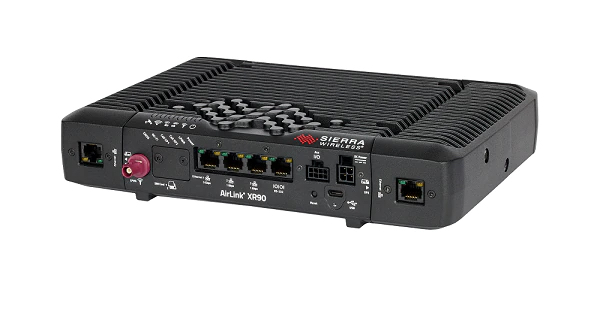
PHOENIX, Ariz.– June 30, 2021 – ON Semiconductor (Nasdaq: ON), driving energy-efficient innovations, today announced that Sierra Wireless (NASDAQ: SWIR) (TSX: SW), a world-leading IoT solutions provider, has selected QCS-AX Wi-Fi 6 chipsets to power the Wi-Fi functionality of its market-leading XR Series of multi-network 5G routers. The supercharged X90 and XR80 routers are designed to deliver high performance and seamless connectivity across 5G cellular, Wi-Fi and Ethernet networks for mission and business-critical applications.
Embedded with the QCS-AX Wi-Fi 6 chipsets from ON Semiconductor, the XR Series delivers best-in-class flexibility and reliability among 5G and Wi-Fi radios while intelligently connecting to the best-performing network at the right time. With up to 2.4Gbps speed in a single band, the QCS-AX can be configured for dual band concurrent operation to provide optimized performance along with simultaneous access point and station capability.
The public safety, transit and utility applications rely on real-time communications, including video streaming, video offload and other data-intensive use cases, to ensure safety and responsiveness. Having uninterrupted and reliable connection is crucial as users in the field and at the station must make timely decisions based on the information received in critical situations. The mobile router can be used for mobility applications or primary, temporary, or backup fixed wireless connectivity, from connecting medical devices in emergency vehicles, to providing continuous and scheduled telematic backup or business-critical connectivity.
Security is a serious concern for all data transmission. With a hardware-accelerated VPN for secure transport, secure boot, unique cryptographic keys, and use of the WPA3™ (Wi-Fi Protected Access 3) protocol, the XR series employs multi-layered end-to-end security to protect data from device to the cloud, enabling customers to reduce security risks in their deployment.
“Leveraging the Wi-Fi expertise from ON Semiconductor, we are proud to introduce this new generation of 5G routers,” said Tom Mueller, vice president of Product Enterprise Networking, Sierra Wireless. “The XR Series offers secure connectivity that enables customers to maximize 5G performance across any network, even in the most challenging environments.”
“The XR Series is a great example of how 5G and Wi-Fi 6 converge to provide high performance and reliable connectivity for mobile enterprise applications,” said Irvind Ghai, vice president of Marketing, Wireless Connectivity and Signal Processing Division at ON Semiconductor. “We are thrilled to collaborate with Sierra Wireless, a pioneer in the use of 5G cellular technologies, and be part of this transformative connectivity adoption to help improve real-time communications for mission and business-critical applications.”
Additional resources & documents:
About Sierra Wireless
Sierra Wireless (NASDAQ: SWIR) (TSX: SW) is a leading IoT solutions provider that combines devices, network services and software to unlock value in the connected economy. Companies globally are adopting 4G, 5G and LPWA solutions to improve operational efficiency, create better customer experiences, improve their business models, and create new revenue streams. Sierra Wireless will work with you to develop the right industry-specific solution for your next IoT deployment whether it is an integrated solution to help connect edge devices to the cloud, a software/API service to manage processes with billions of connected assets, or a platform to extract real-time data to improve business decisions. With more than 25 years of cellular IoT experience, Sierra Wireless is the trusted partner globally to deliver your next IoT solution. For more information, visit www.sierrawireless.com.
Connect with Sierra Wireless on the IoT Blog at http://www.sierrawireless.com/iot-blog, on Twitter at @SierraWireless, on LinkedIn at https://www.linkedin.com/company/sierra-wireless and on YouTube at https://www.youtube.com/SierraWireless.
“Sierra Wireless” is a registered trademark of Sierra Wireless, Inc. “AirLink” is a registered trademark of Sierra Wireless America, Inc. Other product or service names mentioned herein may be the trademarks of their respective owners.
Rugged, transfer-molded modules simplify compact motor drive design

APEC 2021 – PHOENIX, Ariz. – June 14, 2021 – ON Semiconductor® (Nasdaq:ON), driving energy efficient innovations, announces new, integrated, converter-inverter-power factor correction (PFC) modules for use in industrial motor drives , servo drives and HVAC where they are used to drive motors for applications including fans and pumps.
The new NXH50M65L4C2SG and NXH50M65L4C2ESG are transfer−molded power integrated modules (TMPIM) based upon standard aluminum oxide (AI2O3) substrate and enhanced low thermal resistance substrate respectively. Ideally suited to rugged industrial applications with high output power, the modules contain a converter−inverter−PFC circuit consisting of single-phase converter with four 75 A, 1600 V rectifiers. The 3-phase inverter uses six 50 A, 600 V IGBTs with inverse diodes and the dual−channel interleaved PFC comprises two 75 A, 650 V PFC IGBTs with inverse diodes and two 50 A, 650 V PFC diodes. An NTC thermistor is embedded to allow for monitoring of device temperature during operation.
As the module is pre-assembled in an optimized layout and configuration, parasitic elements are very small when compared with discrete PCB-based designs, thereby allowing a wide PFC switching frequency range between 18 kHz and 65 kHz. The highly efficient NXH50M65L4C2SG and NXH50M65L4C2ESG are rated at 50 A permitting use in applications up to 8 kW, and are the latest devices in the ON Semiconductor TMPIM family. Other devices are available with current ratings of 20 A and 30 A.
The compact transfer-molded DIP-26 package measures just 73 mm x 47 mm x 8 mm – a 20 percent area savings over current solutions that enables higher levels of power density. The sealed and robust package includes an integrated heatsink (with 6 mm clearance to pins) and offers high levels of corrosion resistance.
A silicon carbide (SiC) option is also available for further increased switching frequency and efficiency.
The new NXH50M65L4C2SG and NXH50M65L4C2ESG work alongside the FAN9672 PFC controller and gate driver solutions including devices in the new NCD5700x family. The recently introduced NCD57252 dual channel isolated IGBT/MOSFET gate driver offers 5 kV of galvanic isolation and can be configured for dual low-side, dual high-side or half-bridge operation. The NCD57252 is housed in a small SOIC-16 wide body package and accepts logic level inputs (3.3 V, 5 V & 15 V). The high current device (source 4.0 A / sink 6.0 A at Miller plateau voltage) is suitable for high-speed operation as typical propagation delays are 60 ns.
Driving motors in the most efficient way is key to simplifying installation, lowering heat build-up, enhancing reliability as well as reducing system costs. The ON Semiconductor TM-PIM devices standardize the pinout with minimized parasitic to give designers a high performance ‘plug and play’ solution. Coupling the NXH50M65L4C2SG and NXH50M65L4C2ESG with FAN9672 and NCD57252 provides a rapid design path to a sophisticated and efficient motor control solutions.
During APEC 2021, ON Semiconductor will showcase SiC solutions for industrial applications. To register as a visitor to APEC 2021, please visit http://apec-conf.org/conference/registration/.
Additional resources & documents:
Landing page: Industrial Drive Solutions
Video: Robust and Energy Efficient Industrial Drive Solutions
Blog: Robust and Energy Efficient Industrial Drive Solutions
About ON Semiconductor
ON Semiconductor (Nasdaq: ON) is driving energy efficient electronics innovations that help make the world greener, safer, inclusive and connected. The company has transformed into our customers’ supplier of choice for power, analog, sensor and connectivity solutions. Our superior products help engineers solve their most unique design challenges in automotive, industrial, cloud power, and Internet of Things (IoT) applications.
ON Semiconductor operates a responsive, reliable supply chain and quality programs, and robust ESG programs. Headquartered in Phoenix, Arizona, the company has a global network of manufacturing facilities, sales and marketing offices and engineering centers in its key markets.
# # #
ON Semiconductor and the ON Semiconductor logo are registered trademarks of Semiconductor Components Industries, LLC. All other brand and product names appearing in this document are registered trademarks or trademarks of their respective holders. Although the company references its Web site in this news release, such information on the Web site is not to be incorporated herein.
Comprehensive portfolio of wide bandgap devices for high-performance charging solutions

APEC 2021 – PHOENIX, Ariz. – June 7, 2021 – ON Semiconductor® (Nasdaq:ON), driving energy efficient innovations, has announced a pair of 1200 V full silicon carbide (SiC) MOSFET 2-PACK modules further enhancing their range of products suitable for the challenging electric vehicle (EV) market.
As sales of EV continue to grow, infrastructure must be rolled-out to meet the needs of drivers, providing a network of rapid charging stations that will allow them to complete their journeys quickly and without ‘range anxiety’. Requirements in this sector are rapidly evolving, requiring power levels in excess of 350 kW and efficiencies of 95% becoming the ‘norm’. Given the diverse environments and locations in which these chargers are deployed, compactness, robustness and enhanced reliability are all challenges that designers face.
The new 1200 V M1 full SiC MOSFET 2 pack modules, based upon planar technology and suited to a drive voltage in the range of 18-20 V, are simple to drive with negative gate voltages. The larger die reduces thermal resistance compared to trench MOSFETs, thereby reducing die temperature at the same operating temperature.
Configured as a 2-PACK half bridge, the NXH010P120MNF1 is a 10 mohm device housed in an F1 package while the NXH006P120MNF2 is a 6 mohm device in an F2 package. The packages feature press-fit pins making them ideal for industrial applications and an embedded negative temperature coefficient (NTC) thermistor facilitates temperature monitoring.
As part of the ON Semiconductor EV charging ecosystem, the new SiC MOSFET modules have been designed to work alongside driver solutions such as the NCD5700x devices . The recently introduced NCD57252 dual channel isolated IGBT/MOSFET gate driver offers 5 kV of galvanic isolation and can be configured for dual low-side, dual high-side or half-bridge operation.
The NCD57252 is housed in a small SOIC-16 wide body package and accepts logic level inputs (3.3 V, 5 V & 15 V). The high current device (source 4.0 A / sink 6.0 A at Miller plateau voltage) is suitable for high-speed operation as typical propagation delays are 60ns.
Complementing the new modules and gate driver are the ON Semiconductor SiC MOSFETs that provide superior switching performance and enhanced thermals when compared to similar silicon devices. This results in improved efficiency, greater power density, improved electromagnetic interference (EMI) and reduced system size and weight.
The recently-announced 650 V SiC MOSFETs employ a novel active cell design combined with advanced thin wafer technology enabling a best-in-class figure of merit (FoM) for (RDS(on)*area). Devices in the series such as the NVBG015N065SC1, NTBG015N065SC1, NVH4L015N065SC1 and NTH4L015N065SC offer the lowest RDS(on) in the market for D2PAK7L / TO247 packaged MOSFETs.
The 1200 V and 900 V N-channel SiC MOSFETs feature a small chip size that reduces device capacitance and gate charge (Qg – as low as 220 nC), reducing switching losses when operating at the high frequencies demanded by EV chargers.
During APEC 2021, ON Semiconductor will showcase SiC solution for industrial applications as well as presenting exhibitor seminars about the company’s solutions for off-board EV-charging. To register as a visitor to APEC 2021, please visit http://apec-conf.org/conference/registration/ .
Additional resources & documents:
Landing page: Energy Infrastructure
Video: 25kW SiC Module Fast EV DC Charger Power Stage
White paper: Demystifying Fast DC Charging: From Top to Bottom
Articles: Developing A 25-kW SiC-Based Fast DC Charger (Part 1): The EV Application, Developing A 25-kW SiC-Based Fast DC Charger (Part 2): Solution Overview
AdaptivMIMO technology provides flexible configurations for fast 6 GHz adoption
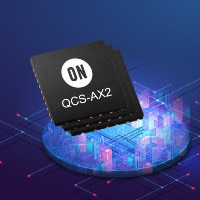
PHOENIX, Ariz. – Apr. 21, 2020 – ON Semiconductor (Nasdaq: ON), driving energy efficient innovations, announced sampling of its new QCS-AX2 chipset family that supports the 6GHz spectrum band based on the enhanced Wi-Fi 6E standard. Designed with a high performance, flexible architecture to maximize usage of the 6GHz band, the new product family is optimized for high-throughput Wi-Fi applications, such as access points, gateways, and mesh networking solutions for dense environments and underserved areas.
The QCS-AX2 series is built on an integrated baseband and RF (radio frequency) architecture that supports key Wi-Fi 6E features, such as orthogonal frequency-division multiple access (OFDMA), advanced MU-MIMO (Multi-User, Multi-Input, Multi-Output), and 160MHz channel support for faster speeds, and SmartScan channel selection for maximum band utilization. The new product portfolio will include the following:
As the Federal Communications Commission anticipates the opening of the 6GHz band in the United States later this year, up to 1,200 MHz of newly available spectrum will be designated for Wi-Fi and other unlicensed use. With almost 5 times of spectrum more than the current 2.4 GHz and 5GHz bands combined, the 6GHz band is accelerating the development of next generation Wi-Fi 6 applications. While the 6GHz client ecosystem takes time to build out, Wi-Fi infrastructure devices, such as gateways, routers, and access points will need to continue to support existing dual band (2.4GHz/5GHz) clients; infrastructure applications such as 6GHz backhaul between gateways and mesh nodes will lead deployments.
ON Semiconductor’s Wi-Fi 6E solutions are designed to accommodate the transition to the 6GHz band with AdaptivMIMO technology while addressing mainstream 6GHz applications. A Wi-Fi 6E infrastructure device with AdaptivMIMO allows the network to operate in the 5GHz or 6GHz band depending on the clients present in a subscriber’s home network to maximize performance, coverage, and utilization. The QCS-AX2 series provides the Wi-Fi performance and connectivity in congested environments to multiple devices that applications demand.
“We are excited about the tremendous opportunities that Wi-Fi 6E opens for the industry. We are in the forefront of building Wi-Fi 6E platforms that enable even better speed, efficiency and performance for the Home, Enterprise, Automotive and IoT segments,” said Irvind Ghai, Vice President of Marketing, Quantenna Connectivity Solutions at ON Semiconductor. “ON Semiconductor is dedicated to innovation in Wi-Fi technology, and will continue to leverage its connectivity excellence to provide end-to-end solutions that accelerate key Wi-Fi 6E ecosystems.”
“Our new generation of QCS-AX2 with AdaptivMIMO allows OEMs fast time-to-market with optimized performance across the 3 bands. As Wi-Fi 6E infrastructure proliferates, it will seed the 6GHz ecosystems. Client devices will also benefit from improved efficiency, lower latency and jitter, and less interference, providing better user experience across applications and environments,” said Simon Duxbury, General Manager & Vice President, Quantenna Connectivity Solutions, ON Semiconductor.
ON Semiconductor is now sampling the QCS-AX2 solutions to customers.
About ON Semiconductor
ON Semiconductor (Nasdaq: ON) is driving energy efficient innovations, empowering customers to reduce global energy use. The company is a leading supplier of semiconductor-based solutions, offering a comprehensive portfolio of energy efficient power management, analog, sensors, logic, timing, connectivity, discrete, SoC and custom devices. The company’s products help engineers solve their unique design challenges in automotive, communications, computing, consumer, industrial, medical, aerospace and defense applications. ON Semiconductor operates a responsive, reliable, world-class supply chain and quality program, a robust compliance and ethics program, and a network of manufacturing facilities, sales offices and design centers in key markets throughout North America, Europe and the Asia Pacific regions. For more information, visit https://www.onsemi.com.
In 2018 the Federal Communications Commission (FCC) of the United States issued a Notice of Proposed Rulemaking (NPRM) that opens up a maximum of 1.2GHz of spectrum between 5.925GHz to 7.125GHz for unlicensed use. The newly released spectrum has the potential to offer over twice the spectrum currently allowed in 2.4GHz and 5GHz. The additional channels allow for not only high speeds such as 10Gbps, but also support more users in dense environments such as Multi-Dwelling Units (MDUs). It is obvious that 6GHz has the potential to usher in a new era for Wi-Fi computing. The FCC’s publication of the NPRM puts it on course for eventual legalization, by most accounts, towards the end of 2020. Other countries, such as those in the European Union and in Asia, will follow suit with their own adoption of 6GHz, most likely in 2022.
While there is little doubt that the introduction of 6GHz is a great development, the mechanics of its adoption into everyday devices that we all have and love are a bit more complex. We can look at the adoption of Wi-Fi 5 (802.11ac) technology as a good model of what will most likely happen. The official 802.11ac specification was published by IEEE in December 2013. By the end of 2016, all smartphones fully adopted 802.11ac. In 2016, there were over 1.4 billion new mobile phones shipped with the majority (over 1 billion) being 802.11ac (Figure 1). If we apply this model for Wi-Fi 6 (802.11ax) 6GHz client devices, it will also likely be approximately 3 years from when IEEE publishes the 802.11ax specifications (June 2020) to when there will be over 1 billion new Wi-Fi 6 client devices, which will be middle of 2023. However, with the addition of 6GHz regulatory approval by the end of 2020, this timeline will most likely be slightly extended to the end of 2023, three years after the FCC fully legalizes 6GHz operation by end of 2020 (Figure 2).
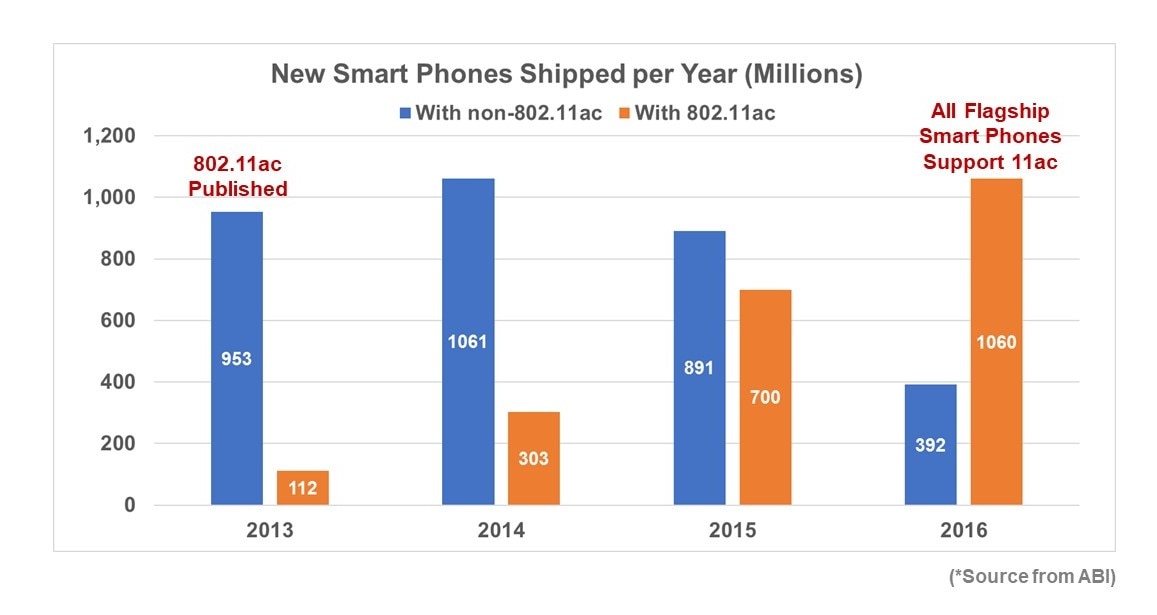
Figure 1. Wi-Fi 5 (802.11ac) Adoption by Client Devices
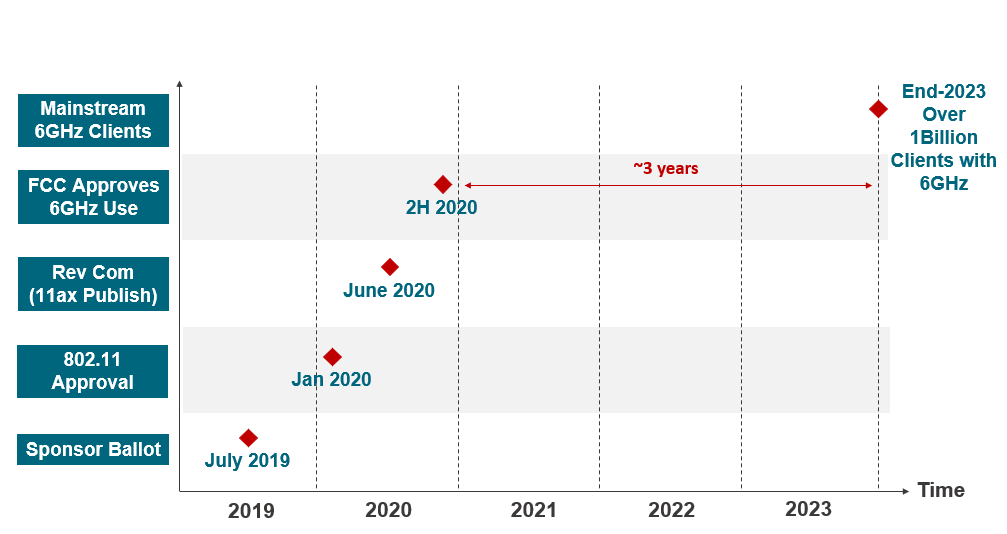
Figure 2. Overall Timeline for Wi-Fi 6 and 6GHz Adoption
With the introduction of 6GHz, it may be deceptively simple to assume that next-generation Wi-Fi 6 infrastructure devices such as home gateways and access points launching in 2020 will all be designed with a fixed architecture, one that dedicates a fixed 4×4 radio to each of the 3 bands: 2.4GHz, 5GHz and 6GHz (Figure 3). As previously stated, since there will be a small quantity of 6GHz Wi-Fi 6 clients until the end of 2023, a gateway solution that devotes any dedicated 6GHz circuitry will be mostly unused for a significant portion of the time. That means the cost and space associated with these new 6GHz components will essentially be wasted inside the gateway. However, service providers must produce and deploy forward-looking gateways as their replacement cycles tend to be longer than that of client devices. These two competing dynamics present an interesting challenge for service providers who are considering the inclusion of Wi-Fi 6 with 6GHz support in their roadmaps.
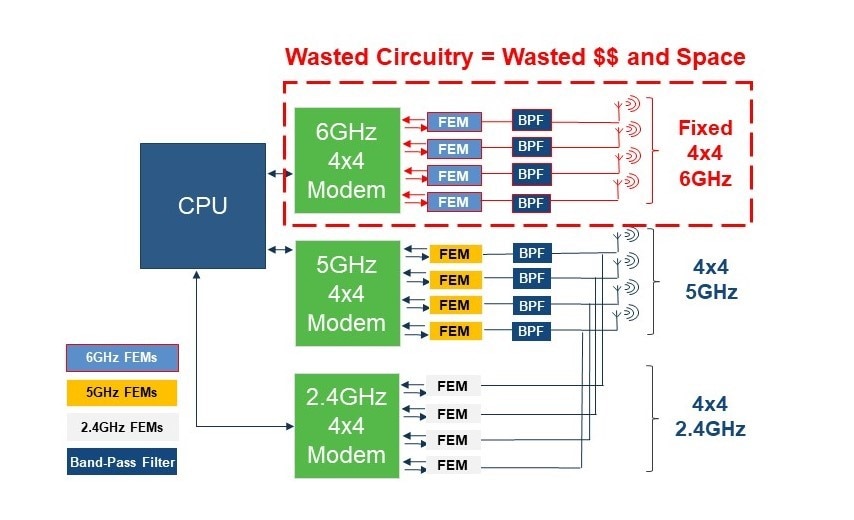
Figure 3. Fixed, Triple Frequency 4×4 Design
A potential solution can be found in a technology called Adaptive MIMO (multiple input, multiple output). Adaptive MIMO was first introduced by Quantenna, now a part of ON Semiconductor, in June 2018 as a way for infrastructure devices to be dynamic and change their 5GHz MIMO configuration between one 8×8 radio and two 4×4 radios depending on the end user’s home environment, such as number of client devices, amount of interference from neighbors and other factors. However, this technology can be an even more powerful solution as it can address the complex issue of 6GHz market adoption for Wi-Fi 6 gateways. Adaptive 6GHz MIMO means that one hardware design can adapt itself between one 8×8 5GHz plus one 4×4 2.4GHz radios (Configuration 1) and three 4×4 radios, each operating at 6GHz, 5GHz and 2.4GHz (Configuration 2). When this design is first deployed, the device infrastructure will reflect Configuration 1. By the end of 2023 with the market adoption of Wi-Fi 6 6GHz, the infrastructure device will operate in Configuration 2. This configuration can be controlled using intelligent analytics which determines the prevalence of 6GHz Wi-Fi 6 clients in a network. It is important to note that Adaptive MIMO design incorporates a new, unique, loss-less 5-7GHz FEM (Front End Module).
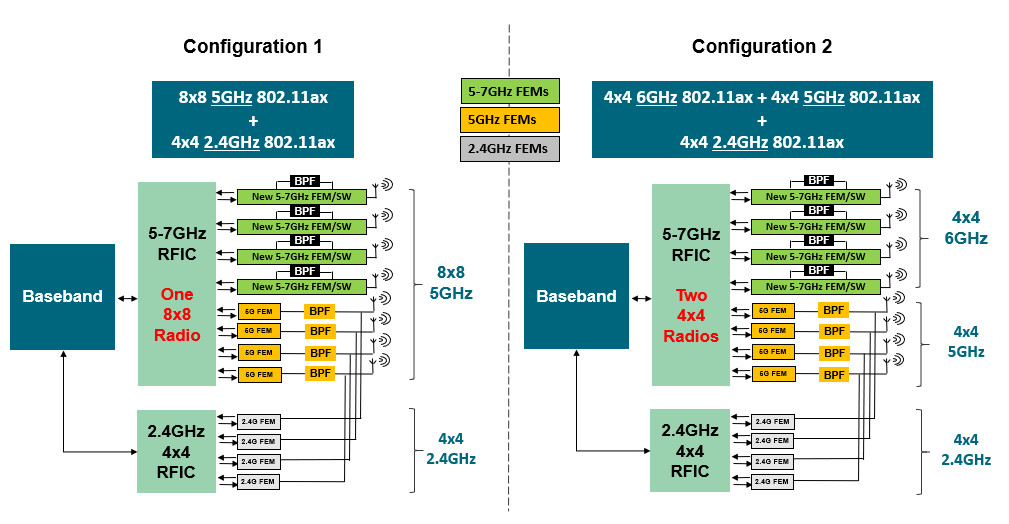
Figure 4. Adaptive 8×8 Design
The introduction of 6GHz is expected to bring about new performance and usability for Wi-Fi 6 devices. While it offers remarkable improvements in upcoming Wi-Fi 6 networks, it also has the ability to dramatically transform the wireless landscape. The next Wi-Fi standard, IEEE 802.11be, is set to establish 320MHz channel operation in the 6GHz band using up to 16×16 MIMO configuration on infrastructure devices. The combination of these developments can increase speed to over 40Gbps, offer previously unseen range performance, and lead to a new age of advance Wi-Fi applications. However, to get there, infrastructure devices must adopt intelligent and cost-efficient architectures, such as Adaptive MIMO.
Learn more at www.quantenna.com